In a world where mass production has dulled much of our daily visual experience, truck art Pakistan stands out like a vibrant rebellion. Bold, handcrafted, and unapologetically expressive, this art form transforms everyday trucks into rolling masterpieces—each one reflecting the heart and soul of its creator.
But truck art Pakistan is more than eye candy on wheels. It’s a deeply rooted cultural phenomenon, an economic lifeline for artisans, and a powerful symbol of identity. In today’s blog, we explore the magic of handmade through the lens of truck art, and why it’s high time this vibrant tradition earned the global love it truly deserves.
.
1. What Is Truck Art Pakistan?
Pakistani truck art is a form of folk art that turns commercial vehicles into mobile murals. From trucks to rickshaws, every surface is a canvas. You’ll see everything from tigers, birds, and flowers to religious symbols, political figures, and poetic calligraphy painted in stunning detail. It’s not unusual to find mirror work, wooden carvings, chains, and elaborate ornamentation adorning the trucks.
The trucks driven by long-distance drivers in Pakistan are decorated in colours, textures and patterns. They brighten up the streets by day and night, when they light up – we’re talking strings of rainbow lightbulbs adorning their exterior.
Every truck tells a story—of the driver’s origins, values, or dreams—and no two are exactly alike.
“A truck is a driver’s home on wheels. The way it looks is the way he feels.” — Local proverb in the trucking community
Truck art is engrained in the nation’s psyche. Every truck is different but has a distinct aesthetic. Each truck tells a story often connected with the truck driver or the region they are from. But the aesthetic isn’t only reserved for trucks. The joyful style has been applied to other modes of transport from public buses to private cars. And in recent years all manner of other things too.
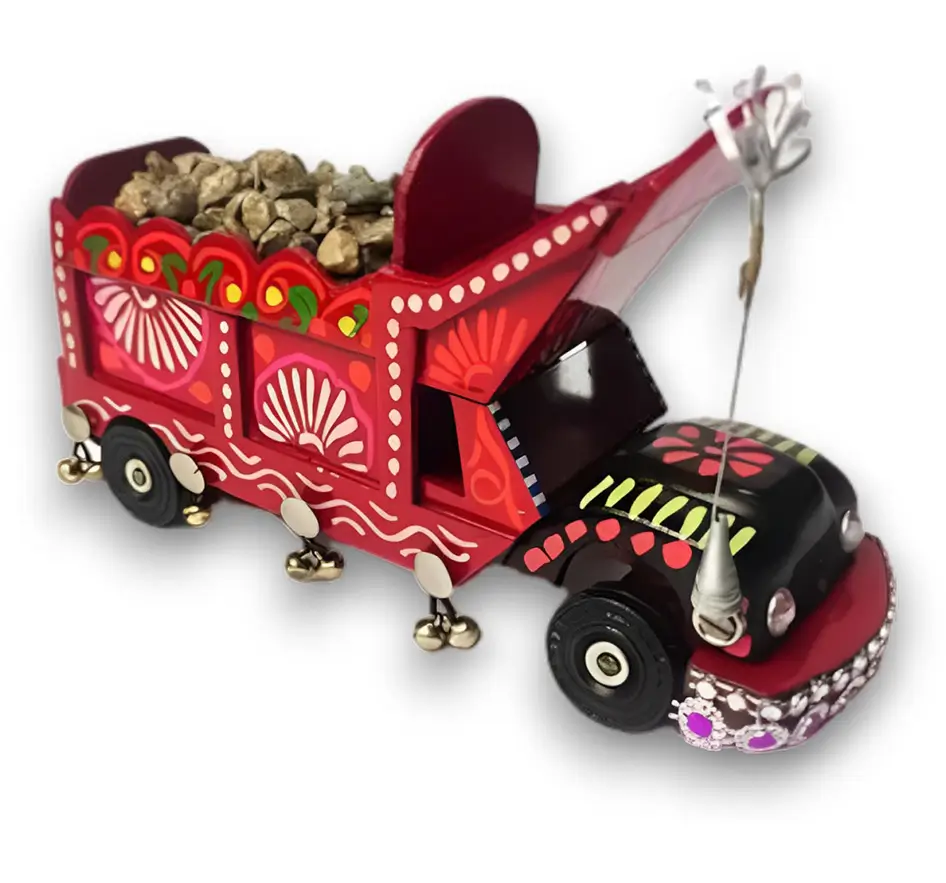
The history of Truck Art Pakistan
Why did truck art start?
The roots of truck art Pakistan can be traced back to the 1920s when trucks became popular for transporting goods. Drivers began personalizing their vehicles not only for aesthetics but also as a way to ease the emotional burden of being away from home for extended periods. Sikh drivers often included images of their gurus, while Muslim drivers depicted Sufi saints to invoke blessings and protection during their journeys. Some drivers affectionately referred to their trucks as their wives, demonstrating the deep connection they felt towards their vehicles.
Changing styles of truck art Pakistan
After independence in 1947, a patriotic theme began appearing on trucks, celebrating the visuals of Pakistan like the landscapes, flowers and animals.
During the 1960s the trucks became more political and carried images of political leaders which helped share propaganda and influence decision-making. But it wasn’t long before celebrities like film stars started appearing on trucks. The first international, non-Pakistani to appear on a truck was martial arts star Bruce Lee.
One aspect that remained elusive though was the artists that became truck decorators; they were largely unknown; despite thire art being appreciated by thousands of people daily. This has changed and master artisans now known and respected, but the earliest artists were not usually credited.
Truck art as communication
Truck art has historically been used as a form of communication; a way of spreading news. Trucks can reach areas that are often inaccessible by other means. They can even access places where there are no phone lines or internet so they play a key role in getting messages across.
In a pre-social media age for example, a major story such as Pakistan winning an important cricket match, could be painted on a truck. Then, as the wheels hit the road, passersby would see the images and understand the celebration.
Truck Art Pakistan for a good cause
In 2019, Roshni, a missing person’s helpline in Pakistan, teamed up with paint brand Berger paints and artist Samar Minallah Khan who painted the faces of missing children on trucks. 3000 children go missing in Pakistan each year and it was hoped the art form could help them be found. The campaign proved successful, and in the first month, 20 trucks were painted, which led to three children being found. Since then, over 100 children have been reunited with their families, all thanks to their portraits appearing on trucks.
Types of Truck Art Pakistan
There are different elements to Pakistani truck art that you’ll see on trucks and in truck art-inspired pieces. Artisans often specialise in a specific technique associated with different regions in Pakistan. These techniques are often combined in one vehicle.
Woodwork
Traditional folk art paintings are the specialty in Rawalpindi. Truck art painters are regarded as Master Artisans who have studied their craft for years. Sadly, just like other folk art practices around the world, it’s on the decline, and that’s why you’re less likely to see colorful hand-painted trucks on your travels. Instead, it’s common to see paint that’s faded from years gone by
2. The Handmade Heart of Truck Art
The beauty of truck art lies in its deeply handmade nature. Skilled artisans—often from families that have painted trucks for generations—spend days or weeks working on each vehicle. With brushes, enamel paints, stencils, and airbrushing tools, they create intricate designs that combine traditional techniques with individual flair.
This is not factory work. There are no templates or assembly lines. Each curve and corner is crafted by hand, driven by instinct, emotion, and an eye for bold aesthetics.
Tools of the Trade:
- Enamel paints & spray guns
- Hand-cut stencils
- Mirrors and reflective materials
- Wood for decorative trims
- Small chisels for carving
- Urdu calligraphy brushes
This handmade quality gives truck art an authenticity and depth that digital designs simply can’t replicate.
3. Supporting Livelihoods & Communities
Beyond aesthetics, truck art sustains an entire creative ecosystem in Pakistan. Painters, woodworkers, metal engravers, and signwriters are all involved in the process. Each truck that gets decorated supports multiple artisans, many of whom have few other job opportunities.
In an age when fast fashion and machine-made goods dominate the market, truck art stands as a proud testament to slow, sustainable, and skill-based craftsmanship. Supporting it means supporting not just an art form, but a community.:
4. Truck Art Pakistan: A Universal Language of Color and Culture
One reason truck art resonates globally is because it speaks the universal language of color, symbolism, and emotion. Despite being deeply rooted in South Asian culture, its appeal is borderless. It captures the imagination, ignites curiosity, and delivers joy.
You don’t need to speak Urdu or Punjabi to appreciate the meaning behind a tiger poised for battle, or the poetic melancholy of a couple painted in longing. These trucks become storybooks in motion, crossing physical and cultural borders.
5. Truck Art Pakistan Goes Global
In recent years, Pakistani truck art has caught the world’s attention. From fashion runways to international exhibitions, its motifs and methods are now appearing on:
- Sneakers & jackets (Nike, Adidas-inspired local brands)
- Furniture & home decor
- Canvas paintings in galleries
- Corporate and NGO campaigns
- Public buses in cities like London and Melbourne (as part of cultural exchanges)
Notable Initiatives:
- Phool Patti: A social enterprise that promotes Pakistani truck art worldwide through collaborations and cultural events.
- Truck Art Child Project: An initiative that uses truck art to spread messages about children’s rights and education.
- Nigar Craft Online Store: Bringing truck art into high-end e-commerce spaces.
This global reach is helping redefine the perception of Pakistani culture—from a conflict-tinted narrative to one of joy, talent, and tradition.
6. Why Truck Art Pakistan Deserves Global Love
Pakistani truck art is not just visually striking—it’s a living heritage, a way of preserving stories, celebrating individuality, and resisting cultural homogenization.
Here’s why it deserves global recognition:
- It represents handmade craftsmanship in its truest form.
- It supports local artisans and traditional trades.
- It reflects a positive, vibrant image of Pakistan.
- It creates a bridge between art and everyday life.
- It teaches us to find beauty in the unexpected—in the back of a dusty old truck.
Conclusion: Truck Art Pakistan in Motion, Culture in Color
Truck art Pakistan is the heart of the highway. It’s where handmade magic meets cultural storytelling, where tradition rides beside innovation, and where the soul of Pakistan travels far and wide.
As the world moves toward celebrating authenticity, slow fashion, and handmade excellence, truck art Pakistan deserves a place in the global spotlight—not just as a visual novelty, but as a cultural treasure.
Let’s not let this art form stay hidden on highways. Let’s bring it to galleries, homes, fashion, and minds around the world.
The Magic of Handmade: Why Truck Art Pakistan Deserves Global Love – FAQ
1. What exactly is Truck Art Pakistan? Truck Art Pakistan is a unique form of folk art that transforms commercial vehicles like trucks and rickshaws into elaborate, mobile murals. It features bold, handcrafted designs including animals, flowers, religious symbols, political figures, and poetic calligraphy, often adorned with mirror work, wooden carvings, chains, and strings of rainbow lights. Each truck is a unique masterpiece reflecting the driver’s story, values, or dreams.
2. Why did Truck Art Pakistan begin, and what is its history? The roots of Truck Art Pakistan trace back to the 1920s when truck drivers began personalizing their vehicles. This was not only for aesthetics but also to ease the emotional burden of long periods away from home, invoke blessings for safe journeys, and express a deep connection to their “home on wheels.” Over time, styles evolved to include patriotic themes post-1947, political messages in the 1960s, and even celebrity portraits.
3. How is Truck Art Pakistan created? Is it mass-produced? No, Truck Art Pakistan is deeply handmade. Skilled artisans, often from families with generations of experience, spend days or weeks meticulously working on each vehicle. They use brushes, enamel paints, hand-cut stencils, airbrushing, and incorporate various materials like mirrors and carved wood. There are no templates or assembly lines; each piece is a unique creation driven by instinct, emotion, and an eye for bold aesthetics.
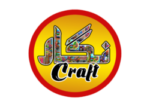
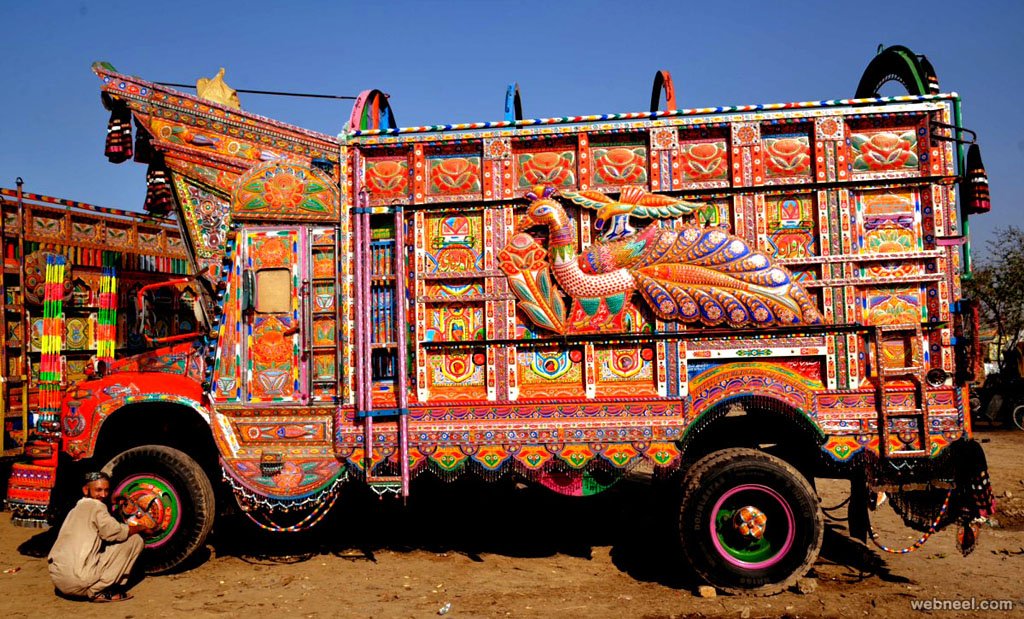
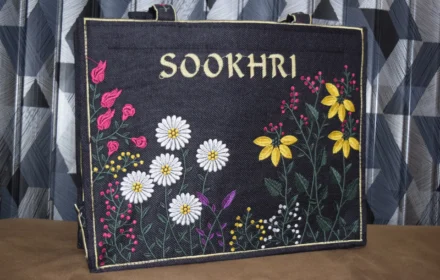
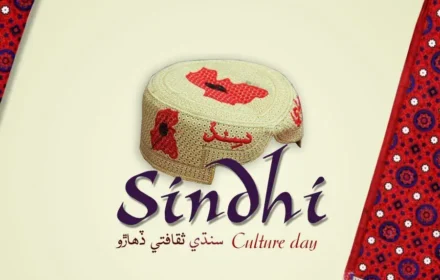
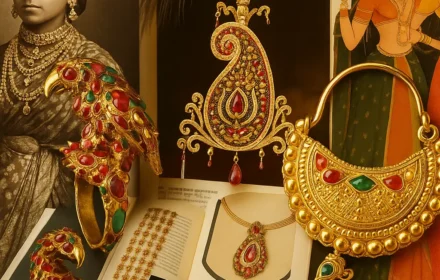

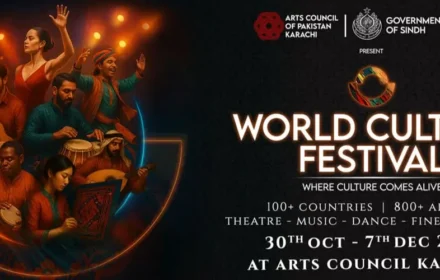


Comments are closed.